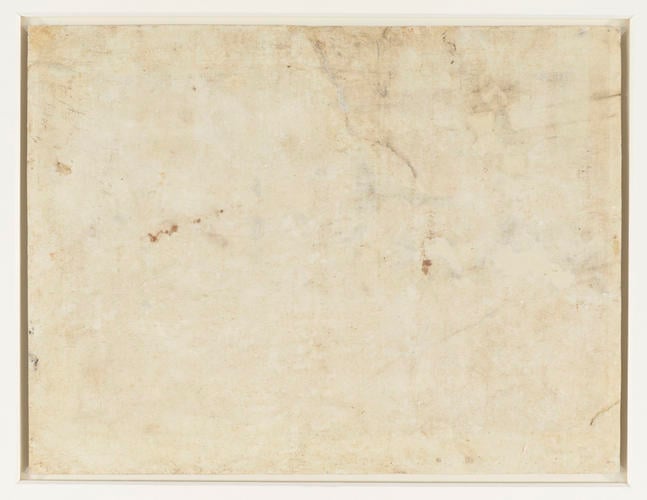-
1 of 253523 objects
The Conversion of the Proconsul Sergius Paulus c.1514
Metalpoint, brown wash, white heightening and later pen and ink, over stylus lines, pin-pointing and black chalk underdrawing, on pale buff prepared paper | 26.9 x 35.4 cm (sheet of paper) | RCIN 912750
-
St Paul strikes blind the magician Elymas, thus converting the Roman proconsul Sergius Paulus to Christianity. The drawing is Raphael’s final study for one of his full-size cartoons of the Acts of the Apostles, to be woven as tapestries to hang in the Sistine Chapel. The seven surviving cartoons are also in the Royal Collection, on display at the Victoria and Albert Museum.
This elaborate drawing corresponds almost exactly with Raphael’s cartoon for the Sistine Chapel tapestry of the Conversion of the Proconsul, often called alternatively the Blinding of Elymas. The presence of an inscription, uniquely among the tapestry designs, identifies the emphasis of the scene: L. SERGIVS PAVLIVS / ASIAE PROCOS: / CHRISTIANAM FIDEM / AMPLECTITVR. / SAVLI PREDICATIONE (‘Sergius Paulus, Proconsul of Asia, embraces the Christian faith through the preaching of Saul.’) The episode is described in Acts (13:6-12): the magician Elymas tried to prevent Sergius Paulus from hearing the preaching of Paul and Barnabas; Paul struck Elymas blind, and thereby the proconsul was converted to Christianity.
With great efficiency, Raphael combines in a single sheet several elements of the creative process – perspective, architecture, figure poses, facial expressions and draperies. The sheet is painstakingly drawn, with a detailed perspectival grid and an elaborate combination of several media, the metalpoint worked over with brown wash and white heightening (the crude touch of another hand can be seen in the pen reinforcement of some outlines, such as the head at far left and the background architecture). Raphael’s oeuvre provides the most brilliant demonstration of the versatility of the demanding medium of metalpoint, which was then rapidly going out of fashion and seems hardly to have been used by his assistants.
The tapestry itself goes further than both drawing and cartoon in including to the left (corresponding to the right here) a pillar decorated with two herms supporting a frieze, above which rises an arched niche containing an antique statue. This strip would lay behind the Papal throne at the intended site for the tapestry, on the left wall of the Sistine chapel. Some such element must have been planned from the outset, for it returns the proportions of the composition to those of the others designed for the side walls of the Chapel and centralises the vanishing point of the perspective, above the right hand of the Proconsul. Two drawings of a caryatid and a herm on either side of a sheet in the Ashmolean were utilised for this pillar (Macandrew 569B).
The drawing corresponds exactly with an engraving by Agostino Veneziano (Bartsch XIV, p.43, no. 48), dated 1516. The print was probably produced with Raphael’s cooperation, furnishing the engraver with this drawing as a model once its preparatory purpose had passed, in part to publicise his invention for a wide audience even before the tapestries themselves had reached Rome.
The drawing is probably that seen in 1688 by Nicodemus Tessin in the collection of Queen Christina of Sweden: ‘... vom Raffael Paulus mit dem blinden vor dem Keijsser, worbeij diese wörter geschrieben stunden: L. Sergius Paulus christianem fidem amplecitur Pauli praedicatione.’ (Christina, Queen of Sweden, Stockholm 1966, p.449). The drawing would then have passed after Christina's death in 1689 through the hands of Cardinal Decio Azzolino and his nephew, Marchese Pompeo Azzolino, thence probably to Livio Odescalchi, on whose death in 1713 the collection was partially dispersed. The note in George III's 'Inventory A', ‘This drawing was bought in Rome’, does imply that it was purchased singly by one of George III's agents, and not as part of a large collection.Text adapted from M. Clayton, Raphael and his Circle, 1999, no. 27
Provenance
Probably Queen Christina of Sweden; in which case Cardinal Decio Azzolino; Pompeo Azzolino; Livio Odescalchi. Purchased in Rome for George III, probably c.1760-70. Recorded in George III's 'Inventory A', c.1810, p. 49, Raffaello d'Urbino e Scuola, no. 1: 'Elymas the Sorceror struck blind; the Composition the same as the large Cartoon. These small Drawings of Raphael were design'd by him in order to be Engraved by M Antonio & others. This drawing was bought at Rome & is Engrav'd by A: Veneziano. 1516'.
-
Creator(s)
(artist)Acquirer(s)
-
Medium and techniques
Metalpoint, brown wash, white heightening and later pen and ink, over stylus lines, pin-pointing and black chalk underdrawing, on pale buff prepared paper
metalpoint, brown wash, white heightening, pen and ink, stylus, black chalk, pale buff prepared paperMeasurements
26.9 x 35.4 cm (sheet of paper)
Other number(s)
Alternative title(s)
The Conversion of the Proconsul
The Blinding of Elymas

